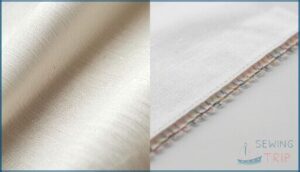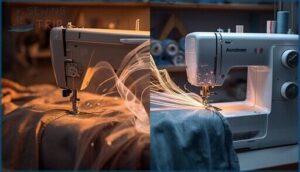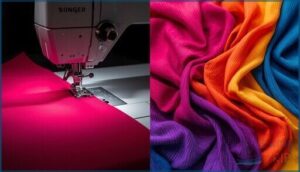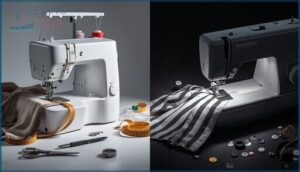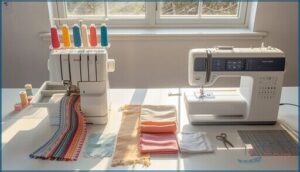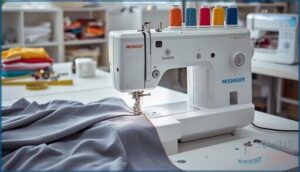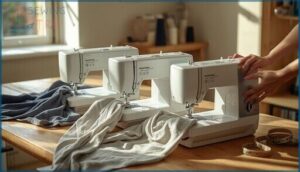This site is supported by our readers. We may earn a commission, at no cost to you, if you purchase through links.
Most sewists assume they need to choose between a serger and a sewing machine, as if the two are competing tools vying for space on the same workbench. That’s the wrong way to think about it. A serger doesn’t replace your sewing machine any more than a chef’s knife replaces a paring knife—each one manages tasks the other simply can’t do well.
Your sewing machine constructs garments, installs zippers, and topstitches details with precision. Your serger finishes seams, trims fabric edges, and locks down knit fabrics so they don’t unravel after the first wash.
Understanding what each machine actually does will help you figure out whether you need one, both, or should stick with what you’ve got for now.
Table Of Contents
- Key Takeaways
- What is a Serger and How Does It Work?
- How Does a Serger Differ From a Sewing Machine?
- Do You Need Both a Serger and Sewing Machine?
- Benefits of Using a Serger in Your Sewing
- Who Should Consider Buying a Serger?
- Choosing The Right Serger for Your Needs
- Frequently Asked Questions (FAQs)
- Conclusion
Key Takeaways
- A serger and sewing machine serve complementary roles rather than competing ones—your sewing machine handles construction tasks like buttonholes, zippers, and topstitching, while your serger excels at finishing seams, trimming edges, and working with knit fabrics that need stretch and professional edge enclosure.
- Sergers deliver significant speed and efficiency advantages by stitching at 1,300-1,500 stitches per minute (versus 600-1,000 for sewing machines) while simultaneously trimming, stitching, and overcasting edges in a single pass, making them indispensable for anyone working with knits, activewear, or high-volume garment production.
- Neither machine can fully replace the other since sergers lack the capability to create buttonholes, install zippers, or produce straight topstitching, while sewing machines can’t match a serger’s integrated trimming, multi-thread edge encasing, or superior handling of stretch fabrics with differential feed.
- Your decision to invest in a serger should be driven by the actual projects you’re making—if you’re regularly sewing knits, activewear, or garments requiring professional finishing, a serger becomes essential, but if you’re focused on quilts, bags, or woven garments, your sewing machine alone will handle the work.
What is a Serger and How Does It Work?
If you’ve heard the term “serger” tossed around in sewing circles but aren’t quite sure what it means, you’re not alone. A serger is a specialized machine that works differently from your standard sewing machine, and understanding its purpose can help you decide if it’s worth adding to your workspace.
Let’s break down what a serger actually is, how it functions, and where it fits into your sewing projects.
Definition and Function of a Serger
A serger—also called an overlocker—is a specialized machine that stitches, trims, and finishes fabric edges simultaneously using an overlock stitch, preventing fraying with professional results. Unlike a standard sewing machine, it employs multiple threads (usually 3-5) to create durable seams. Understanding overlock stitches, thread management, and proper fabric handling unlocks this tool’s potential.
Key functions include:
- Trimming excess fabric while stitching
- Preventing edge fraying
- Creating stretch-compatible seams
- Finishing raw edges professionally
- Speeding production time considerably.
To achieve professional results, mastering the serger settings is essential for peak performance.
Key Features of a Serger
Understanding what sets an overlocker apart starts with its core features. Most sergers run multiple threads—usually 3 to 5—through needles and loopers to form the overlock stitch. Built-in edge trimming blades cut excess fabric as you sew, while differential feed controls fabric movement to prevent stretching or puckering. Speed settings reach up to 1,700 stitches per minute, and adjustable stitch formation lets you fine-tune seam finishing for any project.
When choosing a serger, consider the [overlocker machine features]() that best suit your sewing needs.
Typical Uses in Sewing Projects
Now that you know how an overlocker operates, let’s explore where it truly shines. Sergers excel in specific sewing techniques that transform your garment construction:
- Finishing seams on knit garments—nearly 90% of commercial knit clothing relies on serger seam finishing for flexibility
- Trimming and overcasting edges simultaneously for professional fabric handling
- Creating rolled hems on lightweight scarves and formal gowns
- Constructing athletic wear where edge trimming and stretch preservation matter most
How Does a Serger Differ From a Sewing Machine?
While sergers and sewing machines might look similar at first glance, they’re built for completely different purposes. Understanding these key differences will help you figure out which machine you need for your projects—or whether you’ll benefit from having both in your workspace.
Let’s break down how these two machines compare across four main areas.
Stitch Types and Seam Finishing
Think of your sewing machine as the architect and your serger as the finishing crew. A sewing machine delivers lockstitches with one or two threads—perfect for construction and detail work.
Your serger uses three to five threads in overlock techniques, trimming edges while wrapping them in sturdy loops. That edge-enclosing action controls fraying and adds fabric stability through adjustable stitch density, making seam finishing bulletproof.
Speed and Efficiency Comparison
Regarding stitch speed, sergers blow sewing machines out of the water. Most sergers clock 1,300 to 1,500 stitches per minute, while your sewing machine tops out around 600 to 1,000.
That productivity boost isn’t just about raw speed—sergers trim, stitch, and overcast simultaneously, giving you massive efficiency gains and workflow optimization that slash seam-finishing time in half.
Fabric Handling Capabilities
Sergers handle knits and stretchy fabrics brilliantly thanks to differential feed, which adjusts how fabric moves under the needles to prevent distortion and maintain seam stability. That controlled feed eliminates wavy edges on jersey or spandex by managing fabric tension and accommodating thread stretch.
Your sewing machine can certainly tackle wovens and lighter knits, but when you’re working with high-stretch materials that demand elasticity and recovery, a serger simply outperforms it.
Limitations of Each Machine
Understanding each machine’s boundaries helps you work smarter. While sergers excel at edge finishing, sewing machines tackle construction details—and neither can truly replace the other.
Key limitations to keep in mind:
- Sergers can’t sew buttonholes, install zippers, or create straight topstitching along visible seams
- Sewing machines lack integrated trimming and simultaneous multi-thread edge encasing that sergers provide
- Threading issues and thread tension adjustments prove more complex on sergers with 3–5 separate paths
- Maintenance costs and speed limitations differ markedly in any sewing machine vs serger comparison
Do You Need Both a Serger and Sewing Machine?
You might wonder if investing in both machines makes sense for your sewing setup. The truth is, each one manages specific tasks that the other can’t easily replicate, though there’s some crossover in what they accomplish.
Let’s break down what each machine does best and whether you can skip one altogether.
Tasks Each Machine Performs Best
When you’re ready to dive into garment making, your sewing machine manages the heavy lifting—buttonholes, zippers, and those crisp topstitched details. Meanwhile, your serger owns seam finishing and fabric trimming territory, flying through knit handling at nearly double speed.
For serious sewing techniques and tips, the sewing machine vs serger debate isn’t about choosing sides—it’s recognizing that stitch quality and edge binding require different champions.
Overlapping Functions and Distinct Roles
Think of your machines as a powerful pair rather than rivals. Your sewing machine manages overcast stitches that approximate basic edge work, while your serger owns true overlock stitch territory with integrated edge trimming.
About 25% of sewists report using both for different stages—sewing machine for construction, serger for seam finishing—because fabric handling and thread management strengths don’t completely overlap. That workflow combination boosts sewing efficiency dramatically.
Can One Replace The Other?
Here’s the reality: neither machine can fully replace the other. Industry experts agree—a serger should complement, not substitute, your sewing machine.
Industry experts agree: a serger should complement your sewing machine, not replace it
You’ll need your sewing machine for straight stitching, buttonholes, and zippers. Meanwhile, your serger manages professional finishing and stretch fabric handling that basic machines can’t match.
This machine comparison reveals they’re partners, not replacement options.
Benefits of Using a Serger in Your Sewing
Once you bring a serger into your workspace, you’ll notice advantages that go well beyond what your standard sewing machine can deliver. These machines excel at tasks that would otherwise eat up your time or leave you wrestling with fraying edges and stretched seams.
Let’s look at the specific benefits that make sergers worth the investment for serious sewists.
Professional Seam Finishing
One major advantage of owning a serger is the professional seam finishing it delivers—something that separates homemade garments from store-bought quality. Your finished edges look clean and uniform, boosting both stitch quality and garment longevity. Here’s what makes serger seam finishing stand out:
- Enhanced seam durability through multi-thread overlock construction
- Consistent thread tension across all fabric weights
- Excellent edge finishing compared to a standard overcast stitch on a sewing machine
- Ideal fabric selection support, especially for knits and lightweight materials
- Professional-grade appearance that mimics commercial apparel standards
This level of finish transforms your sewing from hobby work into pieces you’ll be proud to wear or sell.
Trimming and Preventing Fabric Fraying
Beyond those flawless seams, your serger actively protects fabric edges through precise edge trimming. The built-in knives remove 3–7 mm as you stitch, creating uniform seam allowances that resist fraying better than any zigzag finish. Dense overlock techniques wrap multiple threads around trimmed edges, securing loose yarns before they unravel. This combination of trimming and seam finishing delivers fabric stability that holds up through wear and washing.
| Finishing Method | Fray Prevention Strength |
|---|---|
| Serger Overlock | Dense coverage, trimmed edge |
| Sewing Machine Zigzag | Moderate, no trimming |
| Unfinished Edge | High fraying risk |
| Flat-Felled Seam | Maximum protection |
Working With Knits and Stretch Fabrics
Knits and stretch fabrics truly reveal why sergers outpace sewing machines. Overlock stitches move with fabric stretch, preventing seam breakage that plagues standard lockstitches on fitted garments.
Your T-shirt construction time drops 26%—sergers stitch, trim, and finish simultaneously while maintaining elasticity through 20–30% fabric extension.
That seam durability transforms activewear and leggings, ensuring knit construction withstands repeated wear without thread pop or unraveling.
Creating Decorative and Rolled Hems
While sergers excel at practical seam finishing, they’re equally impressive at creating decorative edges that enhance your garments. Rolled hems complete three times faster than standard machines—perfect for formal gowns, scarves, and lingerie.
By adjusting thread tension and choosing decorative threads like rayon or metallic, you’ll achieve lettuce edges, ruffles, and insertion lace.
Your fabric selection matters: delicate silks and chiffons benefit most from serger hemming since the overlock stitch prevents bulk while enclosing raw edges beautifully.
Who Should Consider Buying a Serger?
So here’s the thing—a serger isn’t right for everyone, and that’s completely okay. Whether you should invest in one really comes down to what you’re actually making, how much sewing you’re doing, and where you’re starting from as a sewist.
Let’s walk through who this machine makes the most sense for.
Types of Projects That Benefit Most
Your serger shines brightest when you’re tackling garment construction with knits and stretch fabrics—think T-shirts, activewear, and leggings where seam reinforcement prevents popped stitches. It’s invaluable for knitwear sewing that demands professional fabric finishing without bulk.
Textile crafts involving rolled hems, decorative edges, and multiple layers also benefit tremendously. However, garment making requiring buttonholes, precise topstitching, or intricate patchwork still demands your sewing machine.
The projects that benefit most are those where speed, edge finishing, and stretch capability matter most.
Home Sewists Vs. Professional Use
The gap between home sewing and professional production hinges on volume and consistency. Most home sewists work solo with occasional projects, making a serger optional—your sewing machine manages everyday mending and garment construction fine.
But if you’re monetizing your work through online platforms or building a micro-brand, a serger becomes essential. Professional-grade equipment dramatically improves sewing efficiency and fabric selection capabilities, allowing your home studio to deliver factory-level seam quality that competitive markets now demand.
Skill Level and Learning Curve
Threading complexity demands respect. Most beginners find serger setup considerably harder than sewing machines—you’re managing multiple tensions and pathways instead of one. Here’s what matters:
- Threading takes practice – Expect 6–9 weeks to proficiency versus 4–6 weeks for basic sewing machines
- Error reduction requires patience – Sergers trim as they stitch, so mistakes are permanent; start on scrap fabric
- Beginner tips work best – Master straight seams first, then advance to rolled hems once you’ve built confidence
Starting with a sewing machine first makes genuine sense.
Choosing The Right Serger for Your Needs
If you’ve decided a serger is right for you, the next step is finding the machine that actually fits your needs and budget. There’s no one-size-fits-all answer here—what works for someone hemming knits at home might be overkill for a beginner, and what a production shop needs is a completely different beast.
Let’s walk through what to look for so you can make a choice you won’t regret.
Factors to Consider Before Buying
Before you commit, think about what matters most to your workflow. Budget planning extends beyond the machine itself—replacement blades run USD 20–50, and starter thread cones add USD 30–80. Space requirements, skill assessment, and project volume all shape whether a serger buying guide or sewing machine selection fits your setup. Maintenance costs, from cleaning to professional servicing every 1–2 years, deserve attention too.
| Factor | What to Evaluate | Why It Matters |
|---|---|---|
| Budget | Machine price + thread, blades, needles | Entry models start at USD 250; add accessories and service costs |
| Space | Dedicated work area and storage | Sergers require permanent threading setups; portability varies by model |
| Skills | Threading complexity and learning curve | First-time users often need multiple attempts; air-threading adds USD hundreds |
Entry-Level Vs. Advanced Models
Price points split the market cleanly—entry-level sergers like the Brother 1034D hover around USD 299–599, while premium models stretch to USD 3,500.
Feature sets explain the gap: basic machines offer 6–8 stitches and manual tension, whereas high-end versions deliver 18+ stitches, automatic threading, and programmable controls.
User reviews confirm beginners rate entry models 4.2/5 for ease, though threading mistakes drop 23% with sophisticated automation.
Recommended Sergers for Beginners
You’ll want a model that doesn’t punish learning mistakes. Three options stand out for beginners:
- Brother 1034D – The benchmark for new sewists, priced around $300–$350, with colour-coded threading and reliable stitch quality across knits and wovens.
- Singer ProFinish 14CG754 – Budget-friendly with video tutorials that demystify sewing basics.
- Juki MO-654DE – Quiet, fast (1,500 stitches/minute), and forgiving on fabric choices, though slightly pricier near $500.
Frequently Asked Questions (FAQs)
Does a serger replace a sewing machine?
A serger speeds through professional seam construction yet can’t sew a single buttonhole. You’ll still need your sewing machine for zippers, topstitching, and straight seams—serger limitations make it a complement, not a replacement.
Do I need a sewing machine if I have an overlocker?
Yes, you’ll still need a sewing machine. Your overlocker excels at seam finishing and overlock stitch work, but sewing machines handle zippers, buttonholes, topstitching, and detailed construction that sergers can’t perform.
Which is better, a sewing machine or a serger?
Neither machine is objectively better—each excels at different tasks. Sewing machines handle construction, buttonholes, and topstitching, while sergers deliver enhanced seam finishing, sewing speed, and stretch fabric handling. You’ll benefit most from owning both.
What can a serger do that a sewing machine can’t?
By coincidence, just when you need speed and precision together, a serger delivers simultaneous fabric trimming and multi-thread overlock stitches that wrap edges for professional seam finishes.
These capabilities are something standard sewing machines simply can’t replicate in one pass.
How to maintain a serger for longevity?
Clean lint from knife and looper areas after every session, and oil moving parts every 8–10 hours of use.
Schedule professional serger machine maintenance annually to keep your serger running smoothly for years.
Can a serger replace a sewing machine?
You can’t fit a square peg in a round hole—a serger excels at professional finishing and fabric handling but can’t replace a sewing machine due to serger limitations like buttonholes and zippers, despite lower thread consumption efficiency.
What are common serger threading issues?
Threading sequence errors cause most serger problems—loopers must be threaded before needles.
Tension issues, thread breakage, and skipped stitches often stem from misthreading, incorrect needle placement, or poor looper timing affecting stitch formation.
Are serger stitches suitable for all fabrics?
Surprisingly, 81% of garment makers prefer sergers for knit fabrics. While serger stitches excel on knits and stretch materials, fabric compatibility depends on thread selection, stitch adjustment, and proper seam strength testing for weaving or delicate textiles.
How does serger speed compare to sewing machines?
Sergers outpace sewing machines markedly—usually stitching at 1,300 to 1,500 per minute versus 300 to 1,
This speed comparison reveals why serger efficiency transforms production time, especially when handling stretch fabrics requiring simultaneous trimming and seaming.
How much does a serger cost on average?
You’ll find entry-level serger machines starting around $200 to $350 from brands like Brother, while mid-range models with enhanced features run $400 to $ High-end sergers can exceed $2,
Conclusion
What’s the point of owning professional-grade tools if they’re gathering dust because you don’t actually need them? Whether you need a serger and a sewing machine depends entirely on what you’re making.
If you’re sewing knits, activewear, or anything you want finished like ready-to-wear, a serger becomes essential. If you’re stitching quilts, bags, or woven garments, your sewing machine manages it. Buy the machine that matches your actual projects, not someone else’s workflow.
- https://alyssaraecreative.com/serger-vs-sewing-machine/
- https://www.reddit.com/r/sewing/comments/1l2dbun/people_who_thought_about_buying_a_serger_but/
- https://www.pincutsewstudio.com/blog/do-i-really-need-a-serger
- https://sewgoth.com/do-you-really-need-a-serger-overlocker/
- https://needlesnbeadsnsweetascanbe.com/the-difference-between-sewing-machines-and-sergers/


